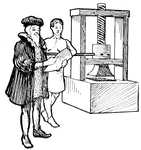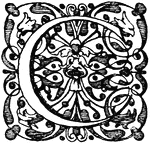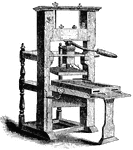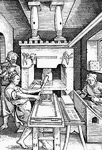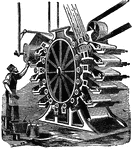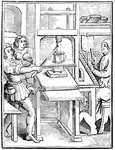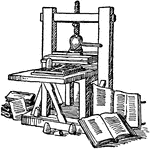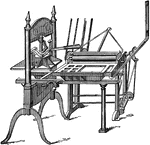
John W. Foster
(1648-1681) Established the first printing office in Boston and is known for the earliest woodblock…

Landing at Parkersburg
"Landing of Federal troops at Parkersburg, Western Virginia. Parkersburg, Va., in 1861 was a thriving…

Village of Clarksburg
"Village of Clarksburg, Western Virginia, headquarters of General Rosecrans. Clarksburg, a post village,…

First Power Press
Tredwell of Boston invented the first power press. The type is raised to meet the platen.
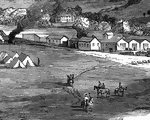
Village of Clarksburg
"Village of Clarksburg, Western Virginia, headquarters of General Rosecrans. Clarksburg, a post village,…
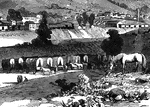
Village of Clarksburg
"Village of Clarksburg, Western Virginia, headquarters of General Rosecrans. Clarksburg, a post village,…
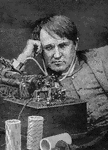
Thomas Alva Edison
"Thomas Alva Edison was born at Milan, Ohio, February 11, 1847, but the family soon after moved to Port…
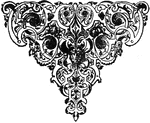
Tail-piece
"A Tail-piece is a piece at the end, as of a series of engravings; an appendage. Also a piece of ebony…
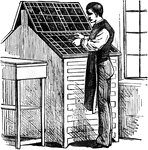
Compositor
"The art of printing from movable types is of comparatively modern origin, only four hundred years having…

Wood Engraving
"The wood used for engraving is boxwood, nearly all of which is imported from Turkey." —The Popular…

Copper-Plate Printing
"In all engraving upon metal plates the traces or marks which are to appear on the paper are cut or…

Printing Press
A mechanical device for printing multiple copies of a text on rectangular sheets of paper. It was invented…
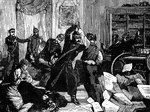
Nihilist Printers
This illustration shows the Russian government destroying a Nihilist printing-office.
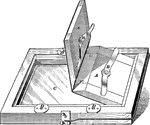
Painting Frame
"A printing frame that is well adapted to sheets not over 17 in. x 21 in. The frame is placed face downwards…
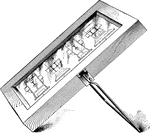
Painting Frame
"A printing frame that is well adapted to sheets not over 17 in. x 21 in. The frame is placed face downwards…
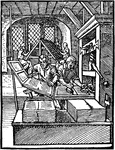
Printing Office
An old-fashioned printing office. The press shown worked by laying paper under a wooden press.

Stereotyping
"Stereotyping is the art of fabricating metal plates resembling pages of type, which impressions may…

Calico Printing
Calico printing was the first "operation connected with the printing of cloth."- Lupton

Modern Printing Press
"The printing press- originating at the middle of the fifteenth, the art of printing continued to be…
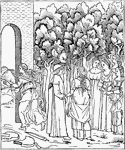
Poliphilo in the Garden
The engraved illustration of Poliphilo in the garden from Hypnerotomachia Poliphili, one of the first…
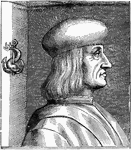
Aldus Manutius
(1449-1515) An engraving print of Aldus Manutius, one of the first printers and founder of the Aldine…
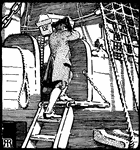
Benjamin Franklin
Benjamin Franklin running away from his home in Boston. He is heading to New York to find work at a…
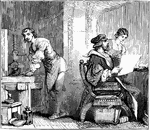
Caxton in the Almonry, Westminster
William Caxton (c. 1415~1422 – c. March 1492) was an English merchant, diplomat, writer and printer.…

Printing Press
A printing press is a mechanical device for applying pressure to an inked surface resting upon a medium…
Shooting Stick
"In printing, a piece of hard wood or metal, about ten inches long, which is struck by a mallet to tighten…
Printers' Galley
"In printing, an oblong shallow tray of brass or wood, rarely of zinc, on which the compositor deposits…
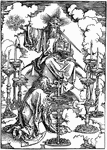
Almighty
The Almighty drawing is a woodcut that was part of the "Apocalypse," a series of fifteen woodcuts created…

The Four Horsemen
The Almighty drawing is a woodcut that was part of the "Apocalypse," a series of fifteen woodcuts created…
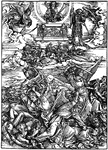
The Blowing of the Sixth Trumpet
The Almighty drawing is a woodcut that was part of the "Apocalypse," a series of fifteen woodcuts created…
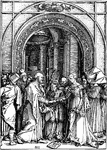
The Marriage of Joseph and Mary
The Marriage of Joseph and Mary is a woodcut that is part of a series "Life of the Virgin" by Albrecht…
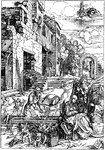
Repose of the Holy Family in Egypt
The Repose of the Holy Family in Egypt is a woodcut that is part of a series "Life of the Virgin" by…
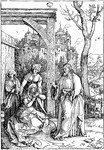
Christ Taking Leave of His Mother
Christ Taking Leave of his Mother is a woodcut that is part of a series "Life of the Virgin" by Albrecht…
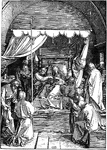
The Death of the Virgin
The Death of the Virgin is a woodcut created by Albrecht Dürer in 1510. It is part of a series…
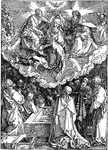
The Assumption and the Coronation of the Virgin
The Assumption and the Coronation of the Virgin is a woodcut created by Albrecht Dürer in 1510.…

Christ Appearing to St. Magdalene
Christ Appearing to St. Magdalene is a woodcut that is part of a series called "Little Passion" by German…

Christ Taken Prisoner
Christ Taken Prisoner is a woodcut by German artist Albrecht Dürer in 1510. It is part of a series…

The Resurrection
The Resurrection is a woodcut by German artist Albrecht Dürer in 1510. It is part of a series called…
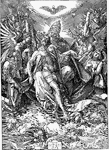
The Holy Trinity
The Holy Trinity is a woodcut that was created by German artist Albrecht Dürer in 1511. This woodcut…
